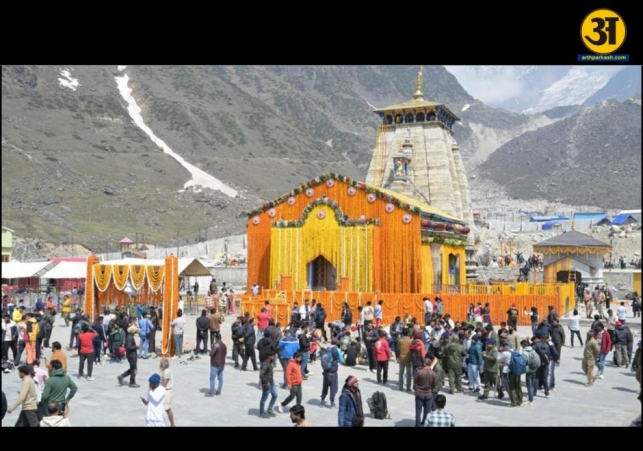
Uttarakhand may deploy anti-drone tech at Char Dham shrines
Uttarakhand government considers deploying anti-drone systems at Char Dham shrines
- By Gurmehar --
- Monday, 26 May, 2025
The Uttarakhand government is considering the use of anti-drone systems at the four Char Dham shrines—Kedarnath, Badrinath, Yamunotri, and Gangotri—and at other key locations in the state. This step is being taken due to rising concerns over aerial threats, especially after Pakistani drones were spotted during Operation Sindoor earlier this month.
Proposal in progress
According to officials familiar with the development, the home department of Uttarakhand has asked the state police headquarters to prepare a detailed proposal. This proposal will be sent to the Union Ministry of Home Affairs (MHA) for approval. Uttarakhand home secretary Shailesh Bagauli confirmed this and said, “During Operation Sindoor, we received communication from the Union MHA suggesting we may consider the deployment of anti-drone systems. We’ve directed the police to prepare a plan accordingly.”
He said the installation of such systems would not only benefit the Char Dham shrines but also protect other important locations across the state. Uttarakhand shares international borders with both China and Nepal, making it a strategically sensitive region.
The Char Dham Yatra, a major Hindu pilgrimage, started on April 30 this year with the opening of the Yamunotri and Gangotri shrines. Kedarnath’s doors opened on May 2, and Badrinath’s on May 4. These four temples attract lakhs of pilgrims every year. So far, more than 1.4 million people have already visited the Char Dham shrines this year.
The Kedarnath shrine, located in the Himalayas, is the most visited among the four and is considered the most sacred. Given its remote location, any threat from the skies—such as drone-based spying or attacks—can be dangerous and hard to prevent without modern technology. That’s why the state is planning to use anti-drone equipment to protect these areas.
The idea of deploying anti-drone systems became stronger after Operation Sindoor revealed how drones were used by Pakistan to carry out surveillance and even try to mislead Indian forces. This raised alarm among security agencies and governments at the state and central levels.
Besides the temples, Uttarakhand is also home to other high-value and sensitive facilities. Dehradun, the capital city, houses the Indian Military Academy (IMA) and the Instruments Research and Development Establishment (IRDE), which is part of the Defence Research and Development Organisation (DRDO). There are also several offices of central government departments in the region.
Civil defence expansion
Along with anti-drone efforts, the Uttarakhand government is also planning to strengthen civil defence across the state. At present, there is only one civil defence unit, located in Dehradun. Now, the government wants to add six more units in other districts that are near international borders or are considered vulnerable. These new units will be set up in Champawat, Pithoragarh, Uttarkashi, Chamoli, Rudraprayag, and Haridwar.
Out of these six districts, four—Champawat, Pithoragarh, Uttarkashi, and Chamoli—share borders with either China or Nepal. This makes it crucial to have quick-response defence systems in these areas.
As per the Civil Defence Act of 1968, any state government in India has the right to establish civil defence units to prepare for and respond to emergencies. The state must inform the Union government after setting them up. Shailesh Bagauli confirmed this and said the government is acting as per the provisions of the law.
These units will help the state respond better during natural disasters, enemy attacks, or any threat to law and order. Their presence will also add to the sense of security for pilgrims and residents in these high-risk zones.
The government of Uttarakhand has already shown interest in the drone sector. Two years ago, the state approved the Uttarakhand Drone Promotion and Usage Policy, 2023. The purpose of this policy is to encourage the use of drones for development and governance purposes such as mapping, agriculture, traffic monitoring, and disaster response.
This policy supports the growth of local drone manufacturers and drone service providers. However, at the same time, the government is also aware of the potential dangers posed by drones used by hostile forces or criminals. Hence, the need for balancing promotion with protection has become important.
ALSO READ: AIIMS Rishikesh doctor booked for distributing sweets a day after Pahalgam attack
ALSO READ: Uttarakhand Police raid multiple locations across 17 states in cyber crime cases
Pilgrim safety a top concern
In 2024, after the portals opened on May 10, nearly 4.8 million pilgrims visited the Char Dham shrines and the Hemkund Sahib shrine. Of these, 1.65 million pilgrims visited Kedarnath, 1.42 million visited Badrinath, 0.81 million visited Gangotri Dham, and 0.71 million went to Yamunotri Dham. An additional 183,722 pilgrims visited Hemkund Sahib, which is also located in Uttarakhand.
These large numbers show how important it is for the government to make sure these areas are safe. Any security lapse could cause panic among tourists and affect the state’s religious tourism, which is a major source of revenue.
Authorities believe that modern security tools like anti-drone systems will help prevent any unwanted aerial intrusions. These tools can detect and disable drones that are flying without permission or that may pose a threat.
This move reflects a broader strategic shift in how hill states like Uttarakhand are thinking about security. Earlier, much of the focus used to be on natural disaster management, especially due to landslides, floods, and snowstorms. But with growing cross-border risks and increasing use of drone technology in warfare, security planning now includes airspace surveillance and protection.
Experts believe that if the anti-drone system proposal gets cleared by the central government, Uttarakhand may become one of the first hill states to have such an advanced layer of protection for its religious and strategic locations.
The final decision will depend on the plan submitted to the Ministry of Home Affairs and the availability of central support and funding. But if approved, the move could be a game-changer for security planning in pilgrimage zones and remote areas.
In the meantime, the Uttarakhand police and home department are working together to finalise all the details of the proposal. The people of the state, especially those working in the tourism and pilgrimage sectors, are hoping that better security will help ensure a safer experience for everyone.
With growing drone threats and increasing numbers of visitors, Uttarakhand’s focus on anti-drone defence and civil defence expansion marks a serious and timely shift in safeguarding its people, temples, and military zones.





